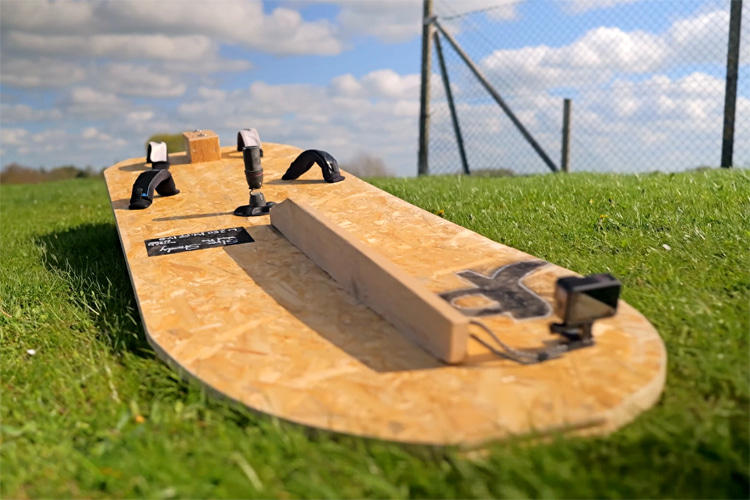Innovations are a product of ideas and experimentation. But can anyone make and ride a windsurf board made from an oriented strand board (OSB)?
One day at night, Nico Prien had an eureka moment. Could he create a DIY windsurf board using a basic wooden plank?
The next day, he got to work and put his plan in motion.
The starting point was a 250-centimeter long, 68-centimeter wide, and 2.5-centimeter thick OSB.
The goal was to keep it simple: no special features like a rocker, channels, rails, or tail - just a plain template with a rounded nose.
The first step was to build a makeshift fin box for a real windsurfing fin, as Prien wanted a bit of performance.
For that, he used wood blocks, allowing them to slide a fin in and out. To ensure a snug fit, the German windsurfer improvised with foil shims.
Next, it was time to determine the position of the mast base.
Prien placed it relatively far back to prevent the nose of the board from diving into waves, so he drilled holes in the board, creating multiple positions for adjustment.
Then, to position the footstraps, Nico aimed for an angle that provided stability and control, so he drilled holes and attached them securely to the board.
Finally, to improve the board's performance, they added a "scoop" by cutting a piece of wood to provide extra lift and maneuverability.
The beauty's name? Slim Shady.
The Water Test
The most exciting of the DIY windsurf board project was testing it out in the water.
Could this unconventional construction survive the sailing experience?
The first thing Nico Prien quickly realized was that the board had insufficient buoyancy, causing it to sink under the windsurfer's weight.
Consequently, it wasn't easy to get it moving and stay afloat.
Maneuvering the board also proved to be challenging, especially in gusty winds. Prien struggled to maintain control and found it difficult to navigate the choppy water effectively.
Despite the initial difficulties, the German eventually had successful runs where he got the wooden windsurf board planing and moving.
The more he rode the OSB, the easier it was to adapt to the board's quirks and learn to anticipate its behavior.
Despite its limitations, the windsurfer achieved a maximum speed of 17.7 knots, demonstrating its potential under the right conditions.
In the end, Prien knew what to do to improve the world's simplest windsurf board: to adjust the footstrap positions, optimize weight distribution, and add features like an air vent screw to prevent water intake.
Hopefully, there will be an upgraded 2.0 version of this crazy and fun design.
Words by Luís MP | Founder of SurferToday.com
